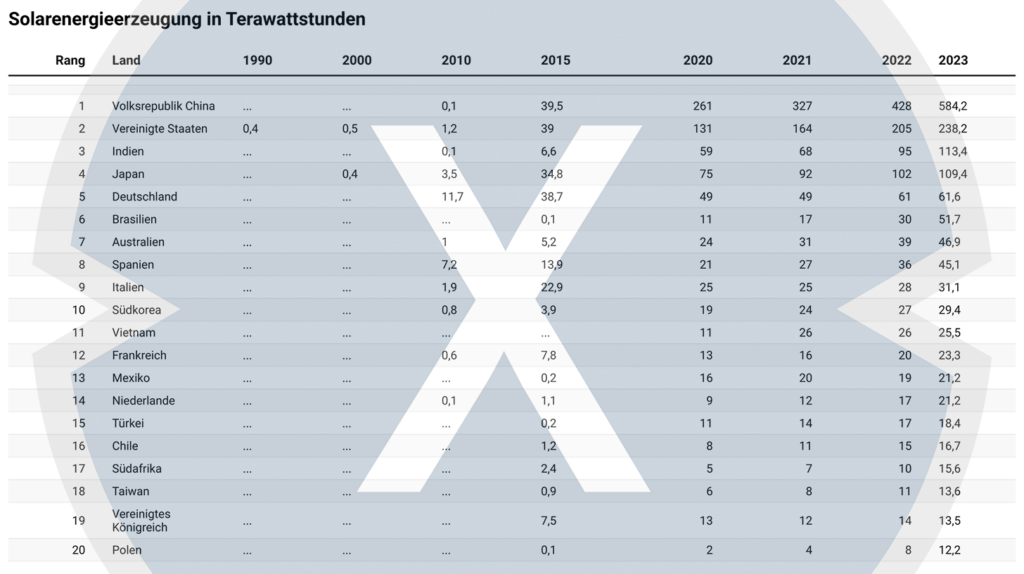Global solar power - From niche product to driver of the energy transition - How innovations made solar energy affordable
Language selection 📢
Published on: December 13, 2024 / Update from: December 13, 2024 - Author: Konrad Wolfenstein

Global solar power - From niche product to driver of the energy transition - How innovations made solar energy affordable - Image: Xpert.Digital
🌞 Solar energy: progress and potential of the global energy transition
🌐 Solar energy is one of the central pillars of the global energy transition. In recent decades, technology has developed dramatically and many countries have expanded their capacity to meet increasing demand for clean energy. The actual energy production from solar sources reflects not only technological advances, but also strategic investments and climatic conditions. In this text we analyze the advances in solar energy production, the underlying trends and the future potential.
1. 🌄 The development of solar energy production
The history of solar energy began on a small scale when photovoltaic (PV) systems were initially used in niche applications such as space travel. However, with technological advances and falling production costs, solar energy has experienced an explosion in usage.
🔑 1990 to 2000: The pioneer years
The early 1990s were marked by the first initiatives to promote renewable energies. Solar energy production was minimal at the time, as high costs and low efficiency of the modules prevented widespread application. Nevertheless, research initiatives and government subsidies in countries such as Germany, Japan and the USA laid the foundation for growth.
💡 2000 to 2010: Market entry and innovations
This decade saw solar energy become increasingly affordable, driven by technological innovations and economies of scale in production. Countries like Germany, which was a pioneer with the Renewable Energy Sources Act (EEG), invested heavily in the expansion of solar energy. The USA and China also began to expand their capacities. Global installed capacity increased exponentially, although actual energy production fell short of potential, with many plants only coming online towards the end of the decade.
🚀 2010 to 2020: The breakthrough
With the introduction of high-efficiency solar panels and the continued decline in prices, solar energy experienced a decade of growth. Countries such as China, India and the US took the lead in expanding capacity. Solar energy has become competitive with fossil fuels in many regions, particularly through falling costs per kilowatt hour produced. In addition, climate agreements such as the Paris Agreement contributed to increased support for renewable energies.
🌍 2020 to 2023: Consolidation and new markets
In recent years, solar energy production has reached new record levels. Leading countries such as China, the USA and India have significantly expanded their production capacities, while new markets such as Brazil, Vietnam and Mexico have emerged. In Europe, solar energy remains a central part of the energy transition, especially given geopolitical tensions and the need to reduce dependence on fossil energy sources.
2. 🌤️ Factors affecting solar energy production
Although installed capacity is increasing rapidly worldwide, there are several factors that influence actual energy production:
🗺️ Geographical and climatic conditions
The availability of sunlight varies greatly by region. Countries near the equator benefit from consistently high levels of solar radiation, while more northern countries such as Germany are catching up thanks to efficient technologies and funding despite fewer hours of sunshine.
⚙️ Technological developments
The efficiency of solar modules has continuously improved over the last few decades. Modern panels can now convert up to 22% of solar energy into electricity, compared to about 10% in the early 2000s. Energy storage technologies also play an important role as they make the use of solar energy more flexible.
📜 Political and economic conditions
Government subsidies, feed-in tariffs and legal regulations have significantly advanced the expansion of solar energy in many countries. However, some countries, particularly developing countries, lack the necessary policy incentives to fully exploit the potential of solar energy.
🔋 Challenges in network integration
The fluctuation of solar power production due to weather conditions presents a challenge for integration into existing power grids. Advances in energy storage and smart grids are necessary to overcome this challenge.
3. 🌟 International trends in solar energy production
The leading countries in solar energy production are often also the largest investors in renewable energy. An interesting dynamic emerges:
- 🌞 China is the undisputed leader, both in terms of installed capacity and actual production. The state is investing heavily in the expansion of solar parks and exports solar technology worldwide.
- 🌎 USA and India follow a long way behind, but are driving regional innovation. Solar energy is particularly crucial in India to meet growing energy demand.
- 🌍 Europe, particularly Germany and Spain, remains a key player despite lower solar radiation as the region relies heavily on efficiency and technological innovation.
- 🌱 New markets such as Brazil, Mexico and Vietnam show that solar energy is also becoming increasingly important in emerging economies.
4. ⚡ Challenges and solutions
Despite impressive progress, solar energy faces several challenges:
💰 Energy storage costs
In order to compensate for fluctuations in electricity generation, cost-effective energy storage is required. Lithium-ion batteries currently dominate the market, but research into alternatives such as sodium-ion and solid-state batteries are showing promising results.
🌾 Space requirement
Large solar farms require significant space, which often competes with other uses. Solutions such as floating solar systems or rooftop systems could help overcome this challenge.
🔄 Materials and recycling
The production of solar panels is material-intensive, and there are concerns about the availability and recycling of materials such as silicon and rare earths. Sustainable production methods and effective recycling are crucial.
🌍 Access in developing countries
In many regions there is a lack of infrastructure and financial resources to use solar energy across the board. International cooperation and funding programs could help here.
5. 🌠 The future of solar energy
Solar energy has the potential to play a leading role in global energy supply. As technology advances and costs fall, it could account for the majority of global energy production by 2050. Hybrid solutions that combine solar energy with other renewable sources such as wind or hydropower could further increase security of supply.
In addition, innovations such as agricultural PV systems, in which agricultural land is simultaneously used for electricity production, could further increase the acceptance and efficiency of solar energy.
Solar energy is undoubtedly one of the most important solutions for a sustainable energy future. Their rapid growth and continuous innovation show that the world is on the right path to leaving fossil fuels behind. However, much remains to be done to fully exploit the potential of this technology while addressing social, economic and environmental challenges.
📣 Similar topics
- ☀️ Future security through solar energy: trends and developments worldwide
- 🌍 Solar energy in global focus: opportunities and challenges
- ⚡ Energy of the future: How solar energy is replacing fossil fuels
- 💡 Technological Innovations in Solar Energy: An Overview
- 🌞 Solar energy worldwide: which countries are leading the development?
- 🌿 Sustainability and solar energy: solutions for the energy transition
- 🔋 Energy storage and solar energy: Overcoming production fluctuations
- 🌱 From agricultural PV to floating systems: new approaches to solar energy
- 🔧 Overcome challenges: materials, recycling and space requirements
- 📈 New markets in solar energy: Emerging countries in focus
#️⃣ Hashtags: #Solar Energy #Energy Transition #RenewableEnergy #TechnologyTrends #Sustainability
🌍☀️ Global solar energy production to 2023 - Difference between cumulative solar capacity and solar energy production

Global solar energy production to 2023 - Difference between cumulative solar capacity and solar energy production - Image: Xpert.Digital
The difference between cumulative solar capacity and solar energy production lies in their definition and application in the field of solar energy. Both terms are essential for understanding global developments and the actual use of solar energy to meet energy needs.
More about it here:
Our recommendation: 🌍 Limitless reach 🔗 Networked 🌐 Multilingual 💪 Strong sales: 💡 Authentic with strategy 🚀 Innovation meets 🧠 Intuition
At a time when a company's digital presence determines its success, the challenge is how to make this presence authentic, individual and far-reaching. Xpert.Digital offers an innovative solution that positions itself as an intersection between an industry hub, a blog and a brand ambassador. It combines the advantages of communication and sales channels in a single platform and enables publication in 18 different languages. The cooperation with partner portals and the possibility of publishing articles on Google News and a press distribution list with around 8,000 journalists and readers maximize the reach and visibility of the content. This represents an essential factor in external sales & marketing (SMarketing).
More about it here:
We are there for you - advice - planning - implementation - project management
☑️ SME support in strategy, consulting, planning and implementation
☑️ Creation or realignment of the digital strategy and digitalization
☑️ Expansion and optimization of international sales processes
☑️ Global & Digital B2B trading platforms
☑️ Pioneer Business Development
I would be happy to serve as your personal advisor.
You can contact me by filling out the contact form below or simply call me on +49 89 89 674 804 (Munich) .
I'm looking forward to our joint project.
Xpert.Digital - Konrad Wolfenstein
Xpert.Digital is a hub for industry with a focus on digitalization, mechanical engineering, logistics/intralogistics and photovoltaics.
With our 360° business development solution, we support well-known companies from new business to after sales.
Market intelligence, smarketing, marketing automation, content development, PR, mail campaigns, personalized social media and lead nurturing are part of our digital tools.
You can find out more at: www.xpert.digital - www.xpert.solar - www.xpert.plus



























